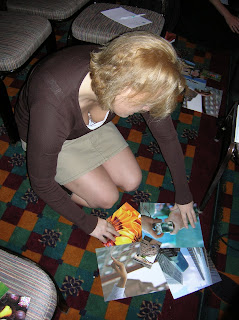VisualsSpeak: Using Images to Build Bridges
I felt really fortunate that the proposal committee was able to get my submission in, because I love this tool so much. The power of using images, once people play with them, speaks for itself. And not just any images, because there are a lot of people already using images from magazines, or postcards. The images in the VisualsSpeak (from here on out I will refer to the tool as: VS), were designed to evoke deep emotional response.
How it Works - in a nutshell
Brain research shows that the right side of the brain is linked to circular, intuitive, visual thinking - which is what we access when we use images. Adding words to describing the images then links in the left side of the brain, which is the literal, logical, linear part. Right + Left = you end up using the WHOLE BRAIN. That tends to make people really remember and begin to integrate learning.

Yup, they go deep, which is what we intended.
From 4,000 images, we narrowed it down to several hundred "types" of images, and then the photo shooting began. We looked for images that represented many universal truths, if you believe in such a thing. We looked for images that weren't simply representations of one thing. (And when I say "we" I'm really talking about Christine Martell and Tom Tiernan, the two owners of VS and about 6 of us who helped do some beta testing.)
Take this image - one of my favorites - for example.

What does it say to you? (I bet each person has a slightly different answer.)
My Session
My goal at the conference was to introduce VS to more people, to give them another tool that I think is fun and innovative. I only had 90 minutes, but we managed to do an ice breaker (chose one image) and a collage activity. Everyone had 5 minutes to chose images around one of two questions:
1. What are my goals for the SIETAR USA 2009 Conference?
2. Who am I as a culture being?
The questions are the key to using the tool. They provide the framework and help people focus and grab on to specific metaphors. (Remember, Right + Left = Whole Brain.)
As you can see from the photos of the collages, it is important to have a non-patterned surface to work with, or a neutral background, otherwise the its hard to focus on the actual collage.

The carpeting in the room was especially problematic!
Other Sessions
Funny enough - I wasn't the only one using VS at the conference.

Marlo Goldstein of Adelante Services used it in her session called "(More than) Two sides to every story", looking at conflict management approaches and activities. Here's what Marlo says about VS:
"VisualsSpeak never fails to first captivate people with the beautiful and intriguing imagery. Then, they are immediately engaged in conversations that seem to go right to the heart of the matter. They find that the images really facilitate their own storytelling as well as their understanding of others. It is a great tool for my work in Conflict Management because it provides an 'in the moment' exercise around differing perspectives (which in real life can cause conflict) and conversations to build understanding across those differences."
Riikka Salonnen of Oregon Health and Science University also used it in her session: Food for Thought - Diversity, Inclusion, and Intercultural Development at OHSU. We used it to create a collage about creating excellent multicultural customer service - a topic I am keen to introduce in Germany.
Right + Left = What it's All About
Using images is certainly not the only way to access deep metaphors, or to connect cognitive learning to changing behavior - but in every situation that I've used VS, whether its with an individual client, a team, or across various cultures - it gets at significant issues in a fun and low risk way. People become attached to their images, and they become attached to the ideas that emerge from them.
If you're interested in how this visual cognitive thing works, try reading:
1. Visual Language: Global communication for the 21st century by R.E. Horn (1999)
2. Creative Brain by Ned Herrman
And if you are in Germany, I'll be presenting it again at the Sprachen & Beruf (Languages & Business) Conference in Düsseldorf, June 16th.

(Yup, this is me - busy pollinating those ideas - ones I hope will bloom into something beautiful!)







What a great post. I have been using VS for almost two years now, specifically with coaching clients (values, vision, passion) and I have found it to be an invaluable tool. What I love about it, other than there is no fuss or muss (no cutting, pasting etc), is that my clients really get an opporuntity to go deep. That comes from not having to be burdened with having to find just the right image (where's a unicorn?), but allows them to open up and find an image that means something to them and then assign the meaning (using right, then left brain instead of the other way around). It's truly a magical process and gets a very profound result.
ReplyDeleteLooking forward to reading more!
Sylvia
www.theintentionalway.com